A few days ago, I was lucky enough to be able to attend a small Q&A session with Alton Brown before his Last Bite show in Minneapolis. One of the questions put to him was about his favorite food destination city. His response? “Well that’s tricky,” he said, because he couldn’t pick just one city, but the answer was Japan (he later narrowed it down to Tokyo, Kyoto, and Osaka). He went on to elaborate about how the Japanese don’t just do their own cuisine so well, but are also masters of the cuisines of other lands. “The best French food I’ve ever eaten was in Japan. The best Italian food I’ve ever eaten was in Japan. The only thing they don’t do well is Mexican, and that’s… horrible [pause for laughs]. And they’re so dang nice there!”
Alton is not wrong. The food that I have experienced in Japan is what my dreams are made of! On this recent 10-day foray into Tokyo, I didn’t eat extravagantly or even very weirdly, eschewing the abundant Michelin starred options and the strange local delicacies you find in such a foreign culture in favor of more casual, local cuisine. There were, in fact, no bugs eaten on this trip, nor fugu (poisonous blowfish), nor horse. I did try natto for the first time at breakfast one day – a fermented soybean dish with a sticky, stringy texture, and an aroma of what I like to call stinky feet cheese, and a flavor reminiscent of super aged parmesan (I was a moderate fan – the texture was off-putting to me, but I liked the actual flavor). But there was also only one fine dining experience, picked primarily for the accompanying Noh Theater, and only two adventures in foreign-to-Japan cuisines (both unplanned, and both Italian, in a pizza joint in the basement of our hotel, and a wee café focused on pasta dishes, both of which were phenomenal).
So our focus was on the casual, local cuisine, street food, konbini fare. And we ate so forking well. Below are my very favorites, the top ten things I ate in those 10 days in Tokyo. These are the foods that I am still thinking about; only the things that I would recommend to my best friend, and will seek out again on my next trip to Japan.
#10: Wedding Strawberry & Pistachio Parfait and Sakura Cream Soda from Kukurihime Coffee
Asakusa – Open 10:00am to 7:30pm Daily (closes at 5pm on Tuesdays)
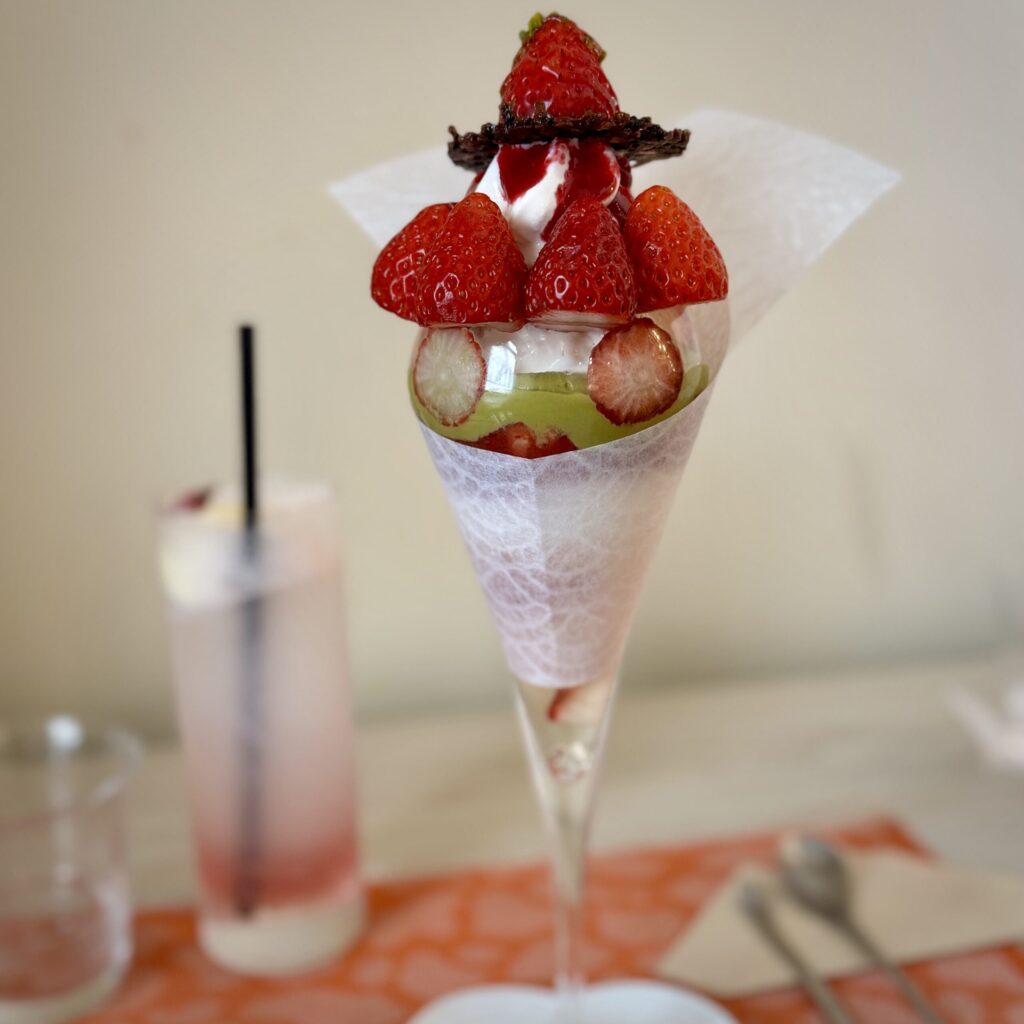
I found this little coffee shop on the social medias in a video about all the instagramable foods from Asakusa, and it was totally worth the hype. First of all, the entire place and experience was adorable – even that flatware brought me joy (and made me want to steal it. I did not, though.) Being spring, everything (like in the rest of the city, and probs country) had a distinct “pink” vibe of strawberries and sakura. I went with what seemed to be their signature dessert – the Wedding Strawberry and Pistachio Parfait, which apparently visually recalls the Japanese bride, and consists of a veritable jenga tower of strawberries and pistachio cream and soft ice cream and some kind of gelatin, all semi-contained within a stemmed glass. I may have lost a gem-like strawberry to the floor in one of my first bites, it was so precariously balanced. It was a beautiful treat though, for all my senses, and so gram-worthy!
To gild the lily, as it were, I paired this with a Sakura Cream Soda, which was not what I expected it to be! In my mind, I had decided that a Japanese cream soda was something like an Italian cream soda, a sparkling beverage with a flavored syrup and cream. Wrong! It’s an ice cream float! So maybe a little bit right if I left it alone till the ice cream melted? Either way, it was dessert on top of dessert, and I loved it. The cherry blossom flavor of the soda was floral and not too sweet, which was perfect with the ice cream melting into it and the parfait on the side.
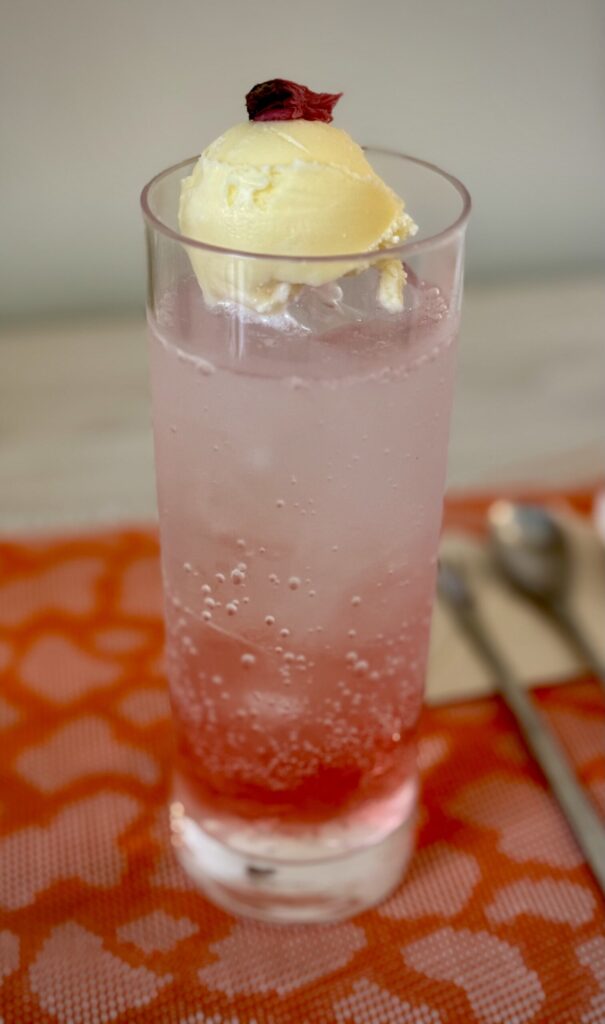
#9: All The Produce – especially the spring strawberries and the muscat grapes, and even more so when they’re dipped in the clear hard-crack sugar coating that is Tanghulu
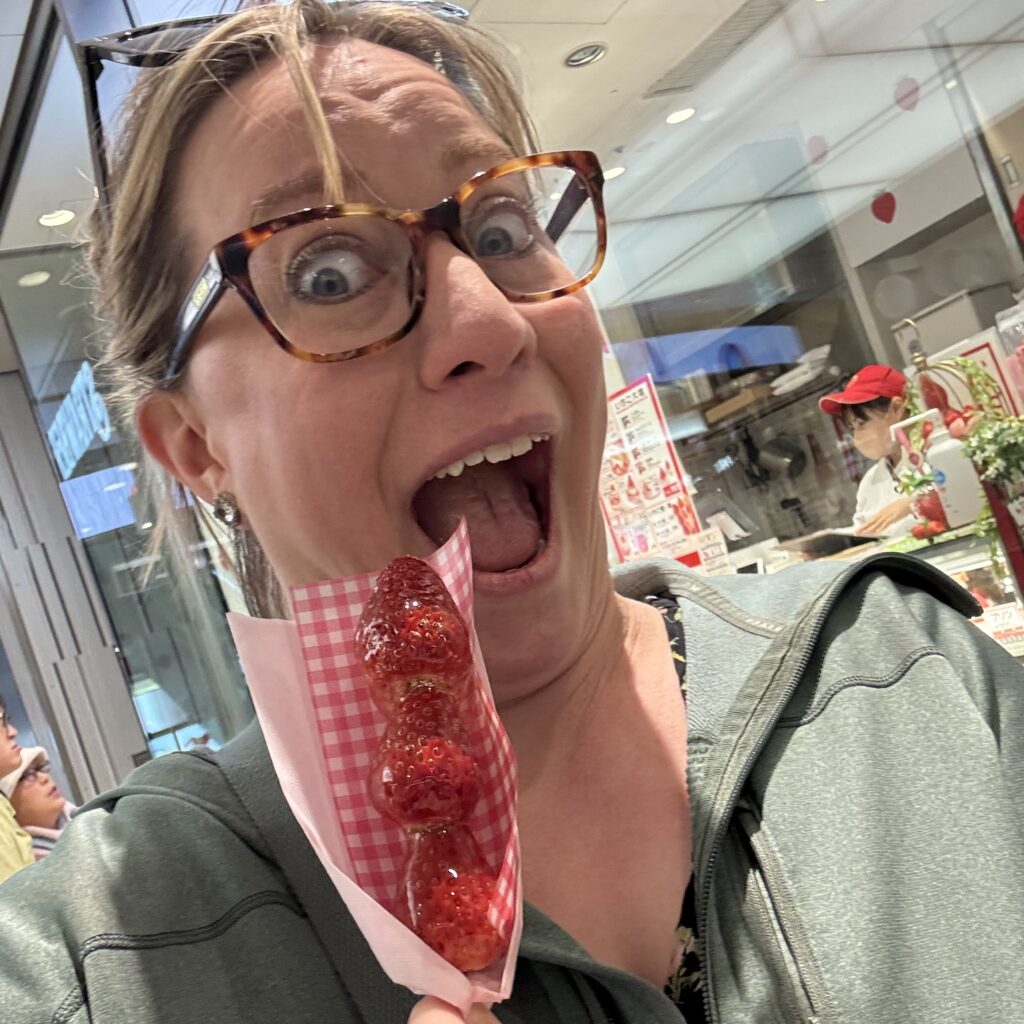
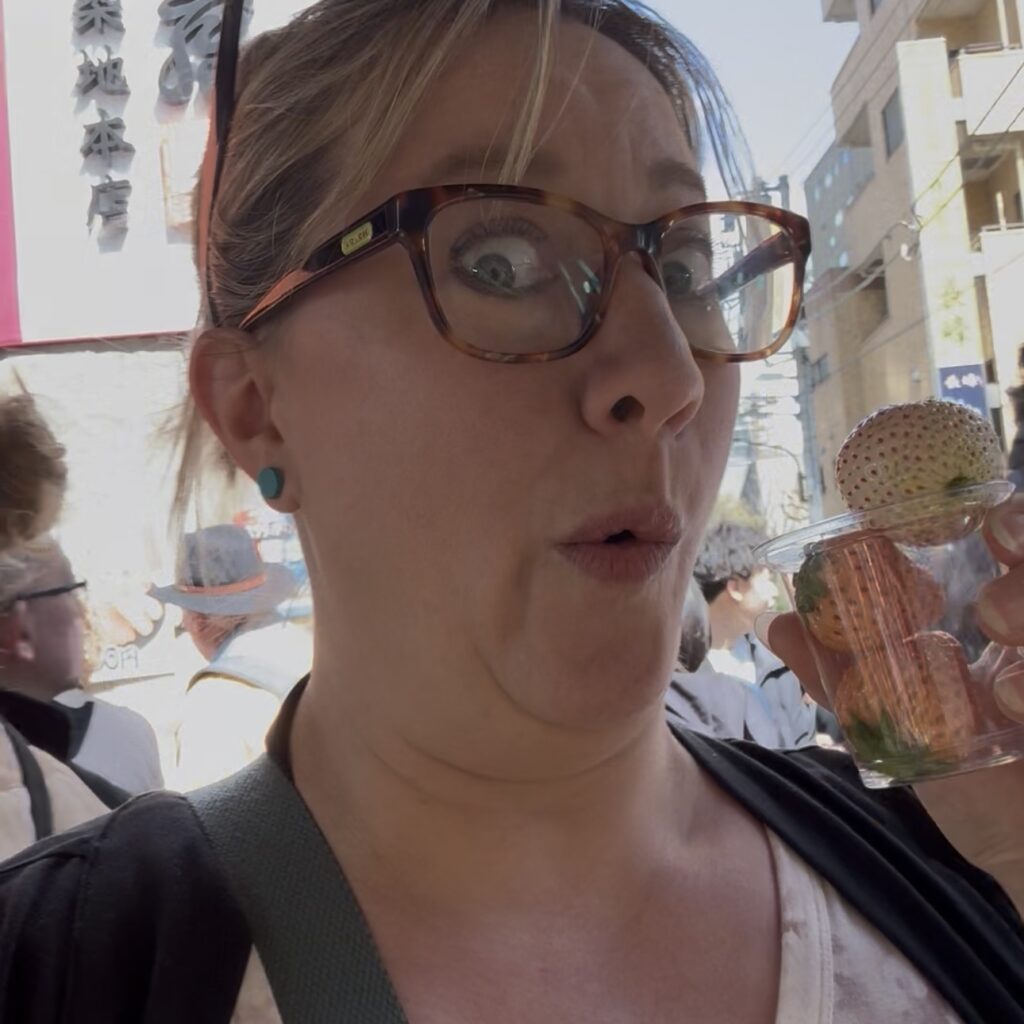
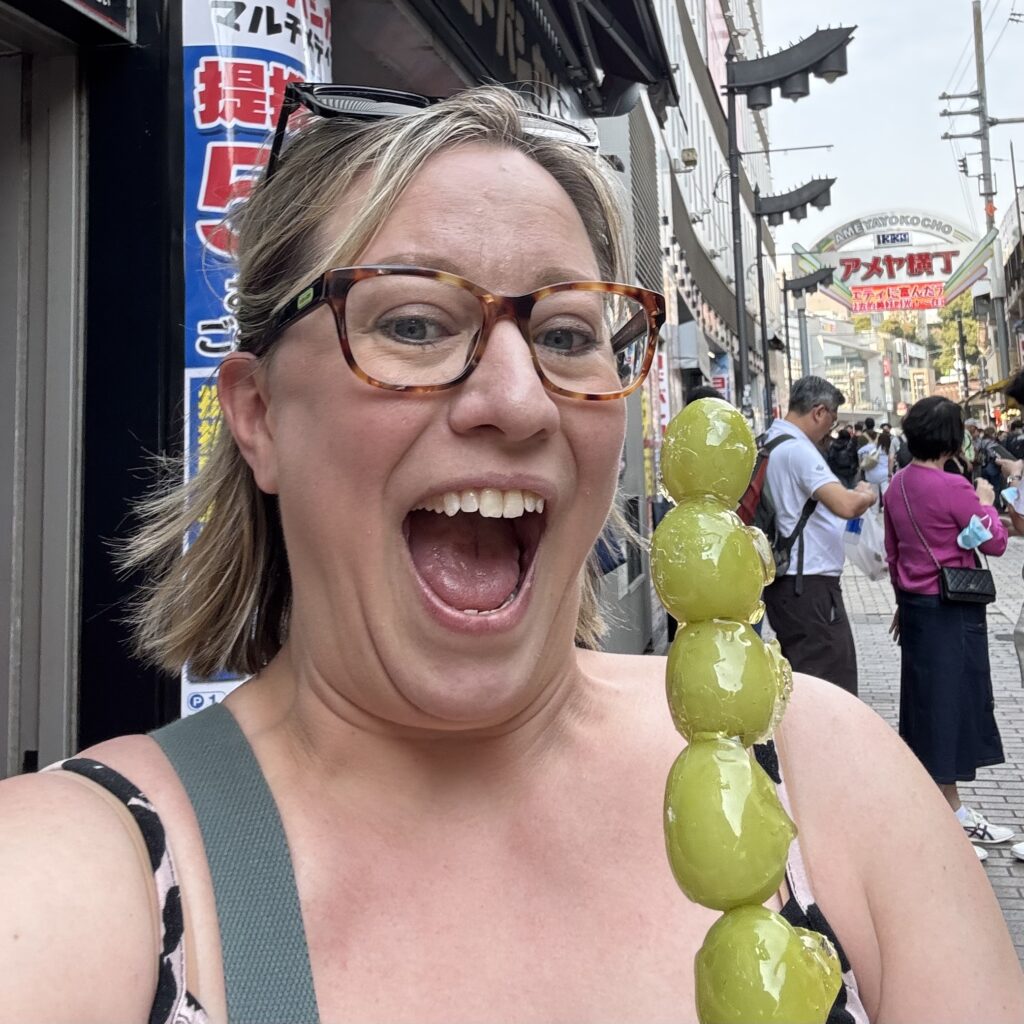
Produce in Japan is expensive, but worth it. I don’t know the factual reasons behind this, but in my mind, they have limited space (being a small, mountainous, island country) and so only grow the very best things, putting all their efforts into quality instead of quantity. Maybe that’s true, maybe not, but either way every fruit and vegetable I ate in Japan tasted like the quintessential essence of that item, distilled several times over. The strawberries… oh man were they the best I’ve ever eaten. And they were priced accordingly, with one small portion of the best variety costing like $50! We didn’t try those, but we tried several others, both from markets and grocery stores, along with a myriad of different pastries and confections focused on the seasonal fruit. Every single time, I was blown away. They were the strawberriest strawberries that could possibly exist!
My favorite way to eat this supercharged fruit, or any other, really, was in Tanghulu. Ohhhh tanghulu! Tanghulu is a pretty simple street food that originated in China, consisting of skewered fruit coated in a glassy crystalized sugar. The shell is clear, hard, and thin, and crackles as you bite through it to the juicy fruit within. We saw all kinds of different varieties of fruit skewered and sweetened this way, but we only tried the strawberries and the muscat grapes (the grapiest grape I may have ever put in my mouth), and they were both just divine.
#8: Takoyaki and “Gyoza in the Skin of the Chicken” from the street vendors at Ueno Sakura Matsuri
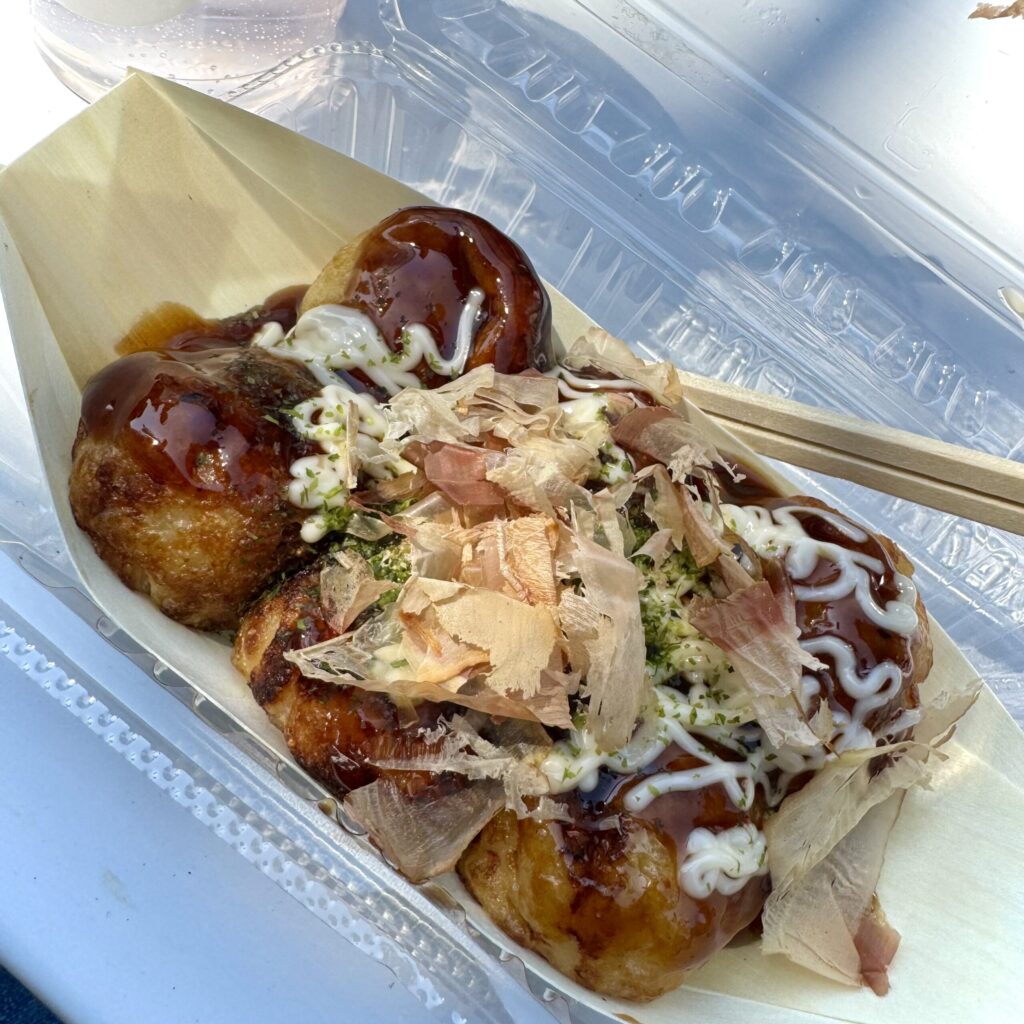
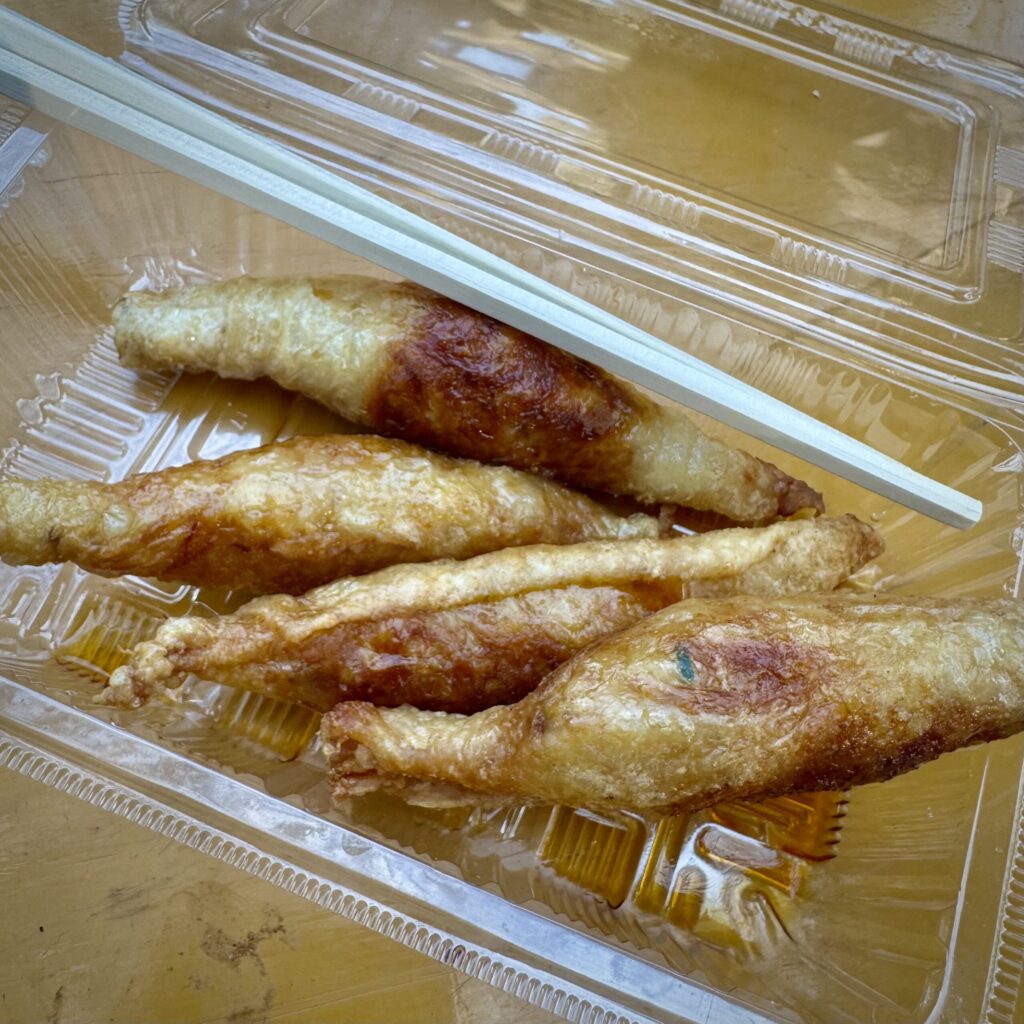
I love street food. I love that it’s quick and casual and inexpensive, and that each vendor only does a couple things (and thus specializes in said things), and that it tends to highlight the best local dishes that local people like to eat. Get a bunch of street food vendors together in one festival-y setting, and I am in hog heaven. I ate a lot during my day at the Sakura Festival in Ueno Park, from shaved ice to a fried patty made of noodles and fish roe and cheese, but the two things that stand out in my memory the most are the Takoyaki and the Chicken Skin Gyoza.
Takoyaki are little savory pancake balls filled with chewy bits of octopus and topped with a sweet-savory Japanese bbq type sauce, Japanese mayo, and bonito flakes. They are delicious, and like pizza or donuts in that even when they’re not that good, they’re still pretty dang good! And these takoyaki were absolutely perfect. Light and fluffy and a bit gooey on the inside, not greasy (they’re traditionally cooked in a special cast-iron pan, not deep fried), hitting all the flavor notes in a beautiful harmony. I eat takoyaki at every opportunity, whether in Japan or not, but these were easily some of the best I’ve ever had.
The ”Gyoza in the Skin of the Chicken,” as the whimsical sign proclaimed these delightful dumplings, were a standout because they were something familiar, made in an unfamiliar way. Gyoza, after all, are a recognizable thing for most people: a little pork meatball wrapped in a thin flour dumpling shell and steamed or pan fried. This twist took that classic little meatball, wrapped it in decadent chicken skin, and deep fried it. The result was a thin, crispy skin, the fat rendered out and not chewy or too thick, and an impossibly moist meat filling – almost as if the fat from the skin had basted it continuously throughout its cooking. Forking genius!
#7: S’more and European Drinking Chocolate from Dandelion Chocolates
Kuramae – Open Daily 10:00am to 7:00pm
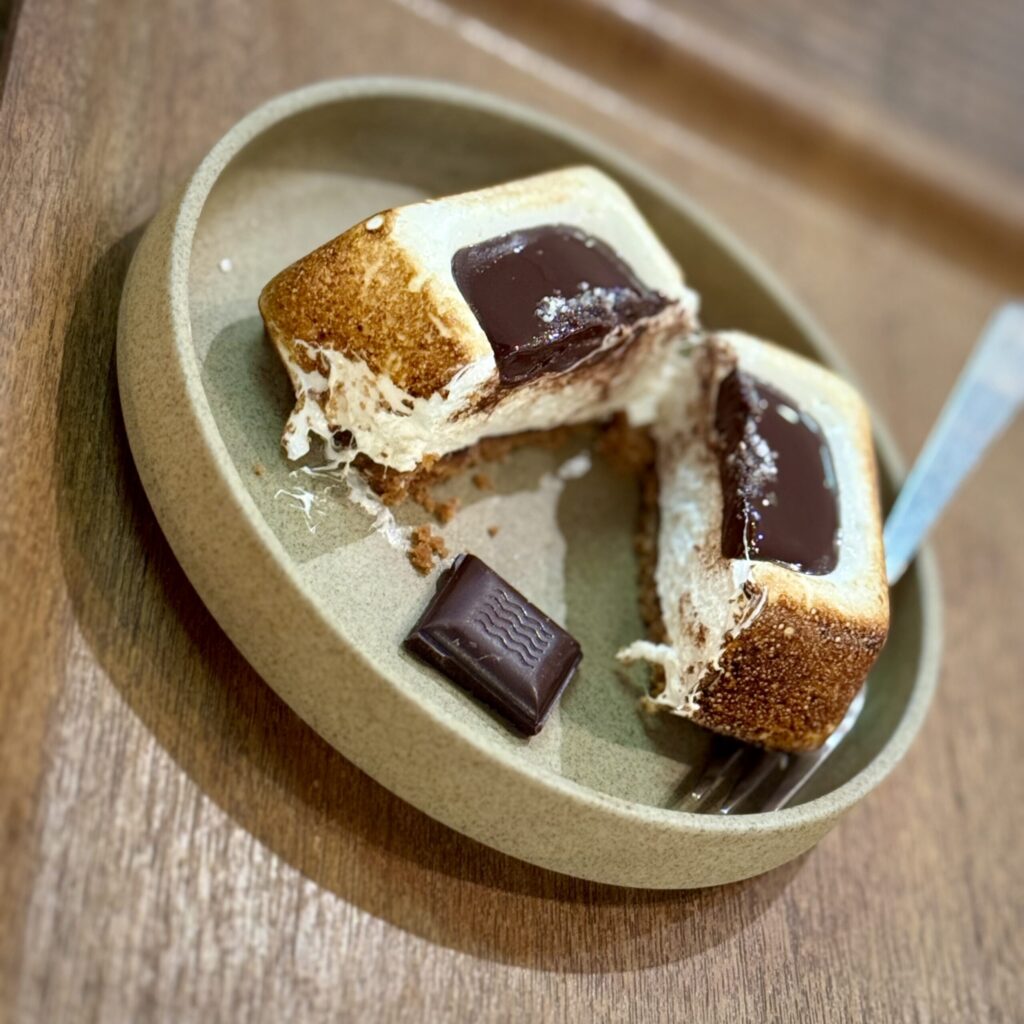
It was a chilly afternoon and we’d been walking around for hours, so we were cold and tired and a bit cranky about it, but we forgot all of that instantly when we walked in the door of Dandelion Chocolate. It was warm, and inviting, and it smelled like chocolate in quite a powerful way. My eyes went round. My mouth fell open. I completely forgot to be cold or tired or cranky. That is how you know a place is going to be spectacular, when just entering changes your whole outlook on life!
The smiling man behind the counter saw all this happen and seemed just tickled by it as he cheerfully gave us the lay of the land and pointed out the best treats. I am always won over by anyone who thinks I make good choices in ordering, and this dude’s enthusiasm about the whole thing was infectious. So we ordered our hot chocolates and coffees and a s’mores confection and some chocolate-bar-of-the-day and settled ourselves at the counter in front of the chocolate factory. Upstairs was a cozy, loungy area that had a more local coffee house vibe, but we stayed downstairs to watch the action. Most of the production floor was shut down for the day, but it was still mesmerizing to watch bars being packaged while we waited.
When our order came, I about died. I got the European Drinking Chocolate, a puddingy-thick, not too sweet chocolate-bar-in-a-cup, and also a cappuccino, which was the perfect contrast with its fruity bitterness. We also shared the S’more – a homemade marshmellow, torched and caramelized around the edges, sitting on a cakey gram cracker style base, with an almost-solid chocolate ganache blob in the middle. We made so so many yummy noises, and I know the chicks behind the counter were laughing at us, but I just could not possibly care. It was heaven.
#6: Asakusa Hanakawado Funachu, an 77yo Unagi Restaurant
Asakusa – Open 11:30am-2:00pm and 5:00pm-10:00pm weekdays; 11:30am-10:00pm weekends. Closed Tuesday & Wednesday.
Unagi, a Japanese freshwater eel, is a prized ingredient in Japanese cuisine. It is rich and fatty and deeply savory, with a meaty-umami flavor that I don’t always associate with seafood. We first tried it at the Tsukiji Outer Market, and my aunt was instantly a huge fan, so when we were looking for some dinner while wandering about Asakusa near Senso Ji temple, and we came across Hanakawado Funachu with its signage displaying eels, we went on in.
It was early, and the place was pretty empty (it filled up by the time we left), and the décor was simple and a bit worn (almost like it had been there for 77 years, and the food was good enough that the tables’ polish didn’t matter as long as they were clean and held up). The staff was so incredibly friendly and helpful. We ordered two preparations – grilled and tempura. A delightful little older man brought it out to us, and I don’t think he spoke much (if any) English, but he communicated in gestures that he also brought a relish and Japanese pepper, condiments for the grilled eel. (Side note: Japanese pepper is a tingly-numbing spice similar to Szechuan peppercorns, but milder and more citrus-y.) There were also a few pickles – perfect with their crunch and acidity after the super rich and soft eel – and a broth that I think was meant to be like a sauce for the eel and rice, but which we drank on its own, not knowing any better. Everything was so good. I don’t normally think of eel as a decadent food, but it is, and this was a meal that left us stuffed, a bit greasy, and feeling like we’d dined like kings.
#5: Chicken Skin Yakitori & Grilled Scallop in Omoide Yokocho
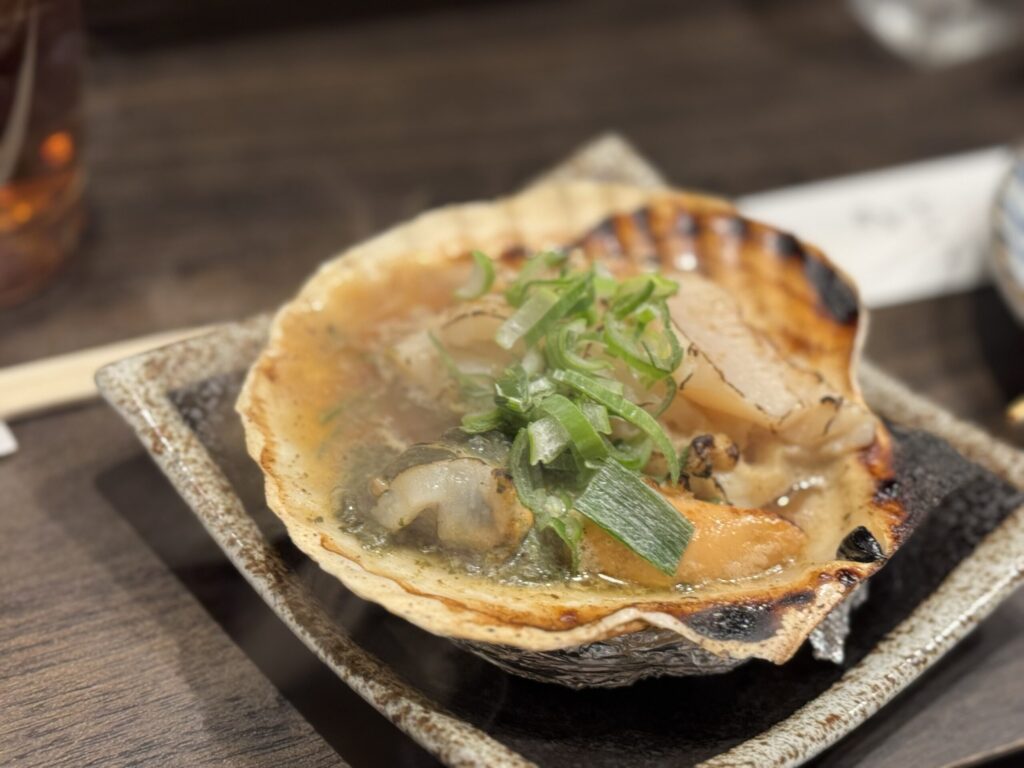
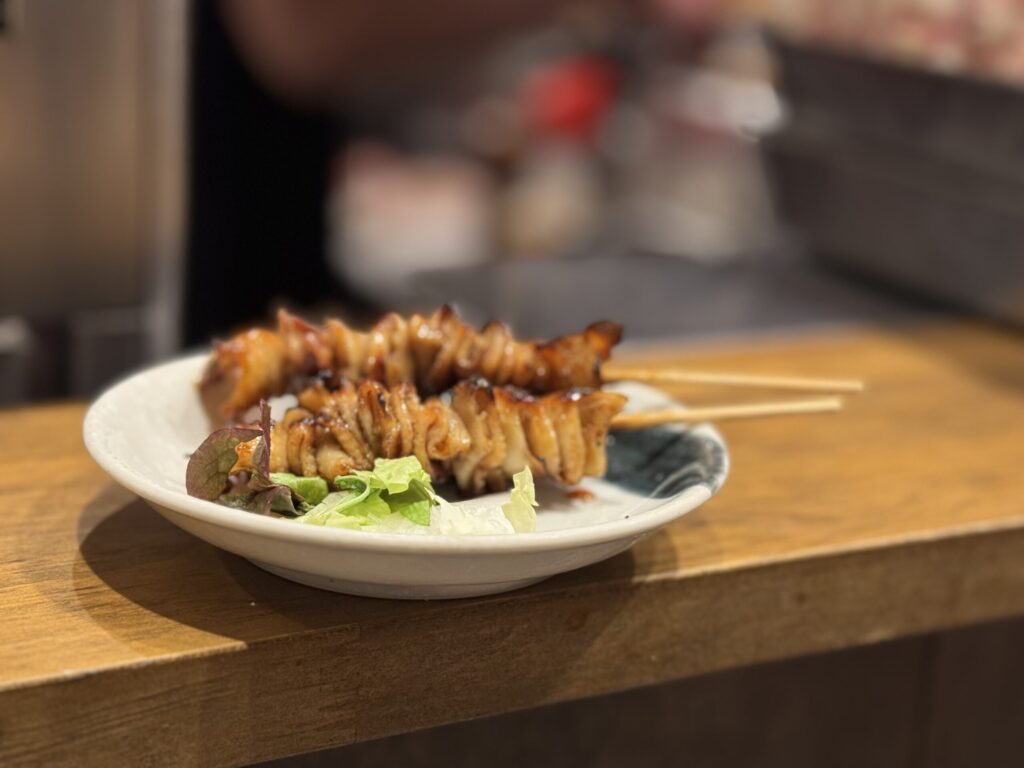
I cannot stress this enough – one of the most exciting and fulfilling and fun place to get some grub in Japan is, in my book, the Yokocho. Entering one is like stepping back in time. They are narrow alleys, sometimes one, sometimes a maze, filled with tiny izakayas for eating and drinking. Sometimes, there are also little shops. Many were black market areas in the times of rationing after WWII. They tend to be pretty quiet and/or closed up until around 5pm, but after they ramp up at dusk, they are lively little hotbeds of local culture and cuisine. And they feel like they’ve been there for hundreds of years.
We visited a few of these magical little time machines, but my favorite experience was in Omoide Yokocho in Shinjuku. We popped into the first establishment that caught our fancy one evening – they had giant scallops on display, and I got a good vibe from the tout out front – and ordered some drinks and a few bites, and settled in to watch them cook up our snacks just behind the counter on a charcoal grill.
First up was the scallop (I couldn’t not order it after seeing it on display!) cooked in its shell with butter and scallions. This is something we saw (and ate) a lot in Tokyo, and it is always good, but this was the best – the scallop was shucked before our eyes, and the sweet, firm meat chopped up with creamy, salty butter and the fresh pop of the green onions and the charred smoke from the grill… all together, you can taste each element distinctly, but they come together to make a harmonious tapestry of flavors in your mouth. Did I burn my tongue in my haste? Yes. Of course I did. But it was totally worth it.
Then came the chicken skin, threaded like a ribbon onto the skewer, grilled over the charcoal, glazed with a sweet and salty and tangy sauce. Chicken skin is not for everyone, mainly because of the texture – it is chewy and fatty in a way some people are not into – but I love it. And the flavor is like you distilled down the essence of the perfect chicken, which I think most people could appreciate if they could get past the mouth feel. In this yakitori style, the texture is amplified though (for me, a very good thing) – folded the way it is, some of it stays springy and dense, while the edges are singed and crisped.
There’s a great explanation and guide to etiquette at here.
#4: Egg Sandos & Melon Buns from the Konbinis
One of my favorite things in Japan is the Konbinis (convenience stores) and their food. This mild obsession probably started with the late, great Anthony Bourdain – it is well known that he loved the egg sandos from Lawsons, calling them “pillows of love”, and he was not wrong. They are so friggin delightful! And so surprising! Who would’ve thought an egg salad sandwich from a convenience store would make my top-ten list of all the great foods from a trip? Def not me, or not before trying them anyway.
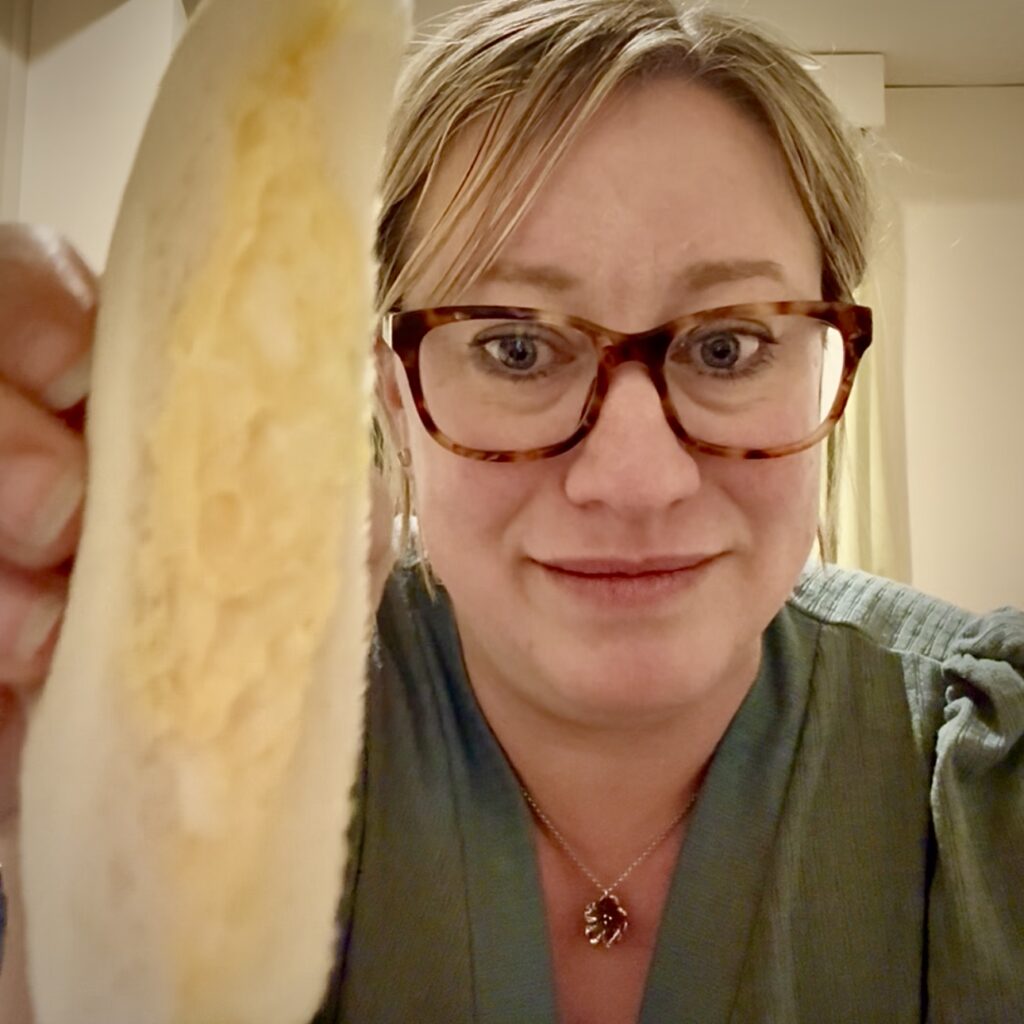
Konbini food in general is a staple of the fast eats genre for Japanese, and the variety, quality, and price point explain why. But those egg sandos? They’re the best of the best. The bread is the first thing. It looks like simple white bread, the kind a million little kids have packed in their lunch boxes, but it is somuch better. The texture is firm enough not to squish, but still light and airy, and not so moist that it turns into goo that sticks to the roof of your mouth. The flavor is delicate, but so much more bready and rich than your run-of-the-mill Bunny Bread. It is, in short, the archetypal ideal of white bread. And then the egg salad – it tastes like eggs, and really good eggs at that, with some of the tang of Kewpie mayo, and a salt level that you know is just right because it is completely unremarkable. I mean, you don’t notice salt, but you also don’t notice the lack of it. And the egg yolks have been whipped into this airy, creamy goo, but there are still some irregular chunks of egg white floating about to give a little variation to the texture. Taken all together, it might be the perfect sandwich. Just trust me and try one, no description will ever accurately convey how good they are!
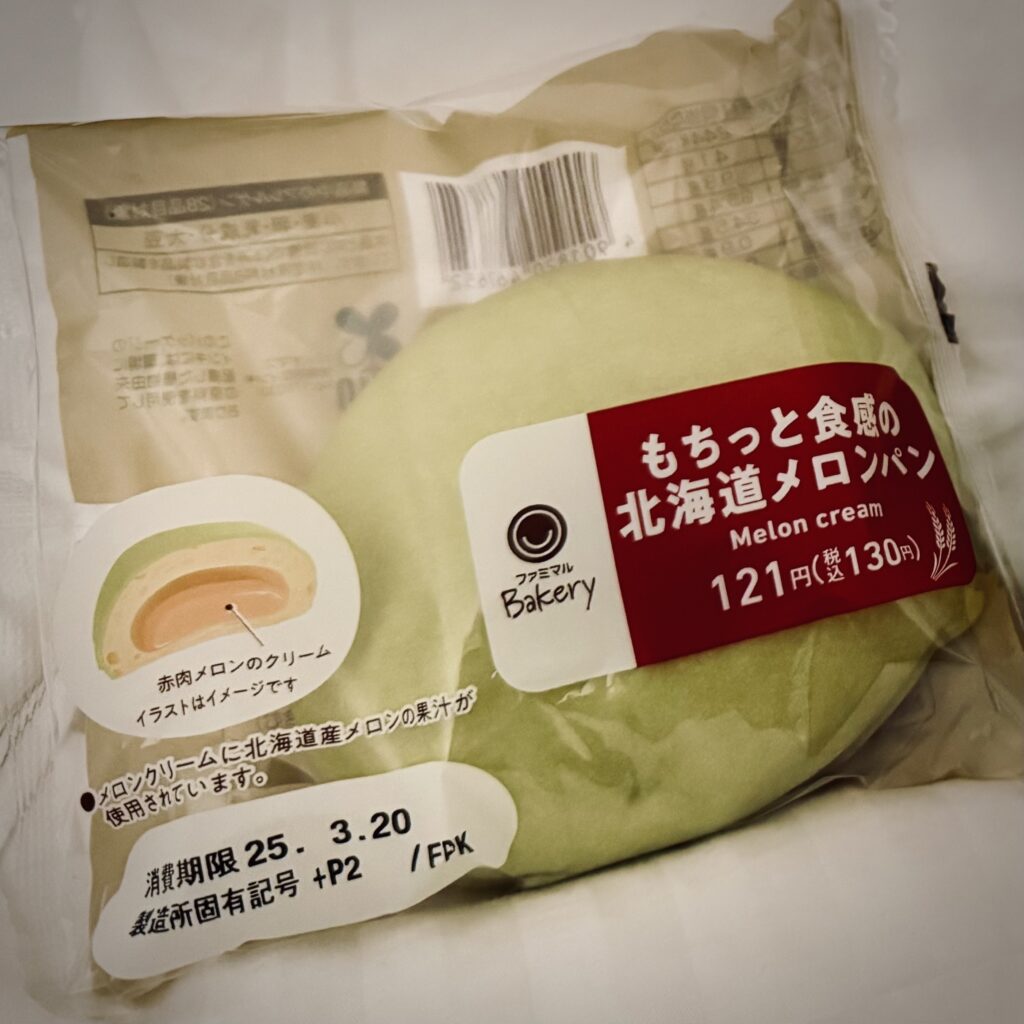
On this trip, I also discovered these crazy melon buns, and quickly developed an obsession with them, too. I still think about them, and miss them, on the regs. I found them at the Family Mart in our hotel lobby, and I don’t know if they’re particular to this konbini, or are seasonal, or what, but they are just such a surprising little treat. I think I first picked one up because I wanted something sweet and it was such an unusual idea to me – melon as the flavor for a cream bun – and the bright green topping caught my eye. And while the logistical elements of the bun are done as well as every cream bun I had in Japan (airy bun that conveys the bready flavor, not too sweet but still satisfying, correct ratio of bread to cream), the melon aspect is what I love here. It tastes like the soul of a honeydew has been stolen from its vessel and transferred into this whimsical confection.
#3: That seafood pasta meal we had at a random little café where no one spoke English, somewhere near Sangenjaya Station.
This is a tricky one to put on this list, because I can tell you almost nothing about it. I took no pictures of our food or the spot, and despite all my efforts, I cannot find the little restaurant on maps! All I know is we decided to grab a bite before riding the retro street tram west, and we wandered a bit because not much was open at the time, but how far and in what direction I cannot say. It was a small little place, with a long bar (behind which was the wee open kitchen) across from a row of small tables (maybe 6 or 8 2-tops?) that were arranged along the big front windows. I think there was an additional 4-top on the end wall. The tables were wood; there was lots of light. No one spoke any English; the menus were in Japanese and quite simple (a lunch set of soup or salad with one of maybe 5 pastas and a special or two?). We got two different pasta dishes, both with seafood I think, and they were wonderful. That’s it. Everything I remember, and it’s not much, and incredibly vague, and yet it stands out strongly as one of my favorite meals of the trip! Maybe it was the authentic feeling of being the only foreigners, or the lack of plan that led us there, or the simple choices made from the finest, freshest ingredients. I loved it.
So I guess the moral of this story is not to follow other’s recommendations all the time. Wander about and find something that feels right; trust your instincts and your google translator, and put yourself out on a limb. It’s the best way I know to find the je ne sais quoi of a place, the magic that will keep you traveling and exploring and tasting new things for the rest of your life.
#2: The Giant Box of Uni from Tsukiji Outer Market
Tsukiji – 9am to 2pm daily (each shop has its own hours, and many are closed on Sundays and/or Wednesdays)
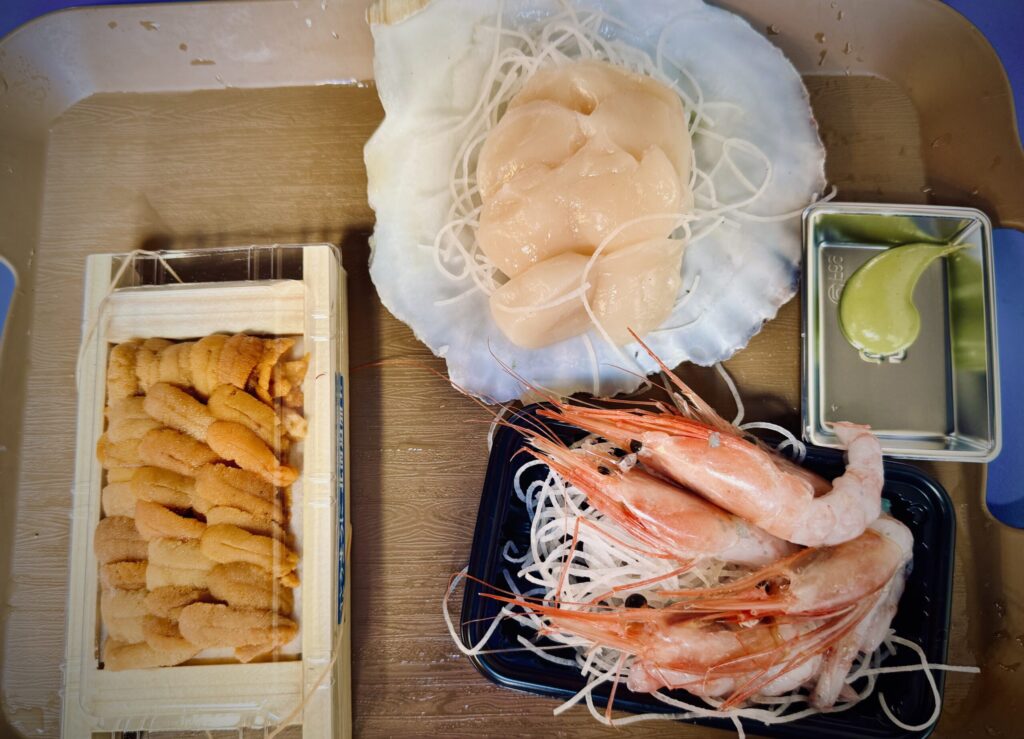
If you like food, or local culture, or a festive atmosphere, you must check out this fabulous experience. Everything about it tickles me. Wandering down the streets, checking out all the independent stands with their local foods, listening to the touts yell their offerings in Japanese and English, smelling the various meats and seafoods cooking on grills and with blow torches, jostling with the crowds… it is a full sensory delight. And the things to eat? Easily some of the best things you will eat while visiting the country, and maybe in your whole dang life.
We ate a lot of different things while wandering the market one day, but my favorite from this trip (and my favorite memory from my last trip, in 2018) is the nonsensically sized trays of uni you can get for practically nothing. I mean, I literally spent 500 Yen (less than $4) for some 30 pieces of sea urchin. At a sushi restaurant in the states, you’re doing really well if you pay that for one piece. And just to have that much of this delectable delicacy in one sitting? It blows my little brains out! So yes, the scallops, both raw and cooked, and wagyu skewers, and insane little strawberries were all fabulous, but nothing will ever thrill me so much as that giant box of uni.
and my number one favorite, best eats in tokyo, japan…..
Udon Shin
Shinjuku – Open 11am to 10pm daily – CASH ONLY
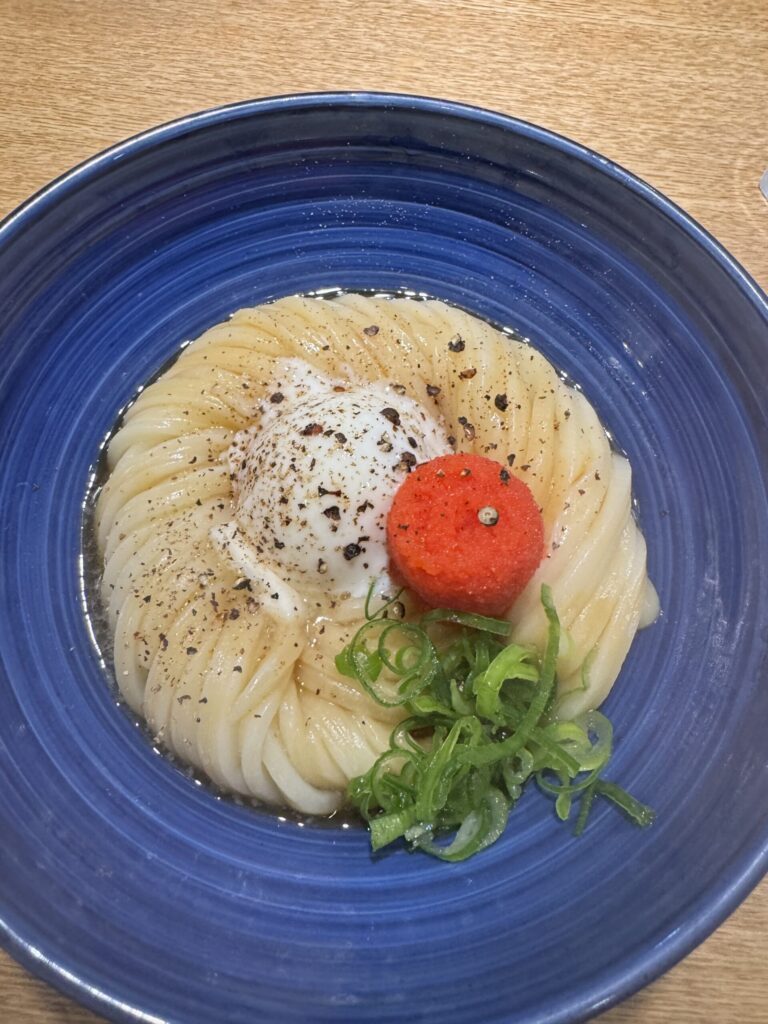
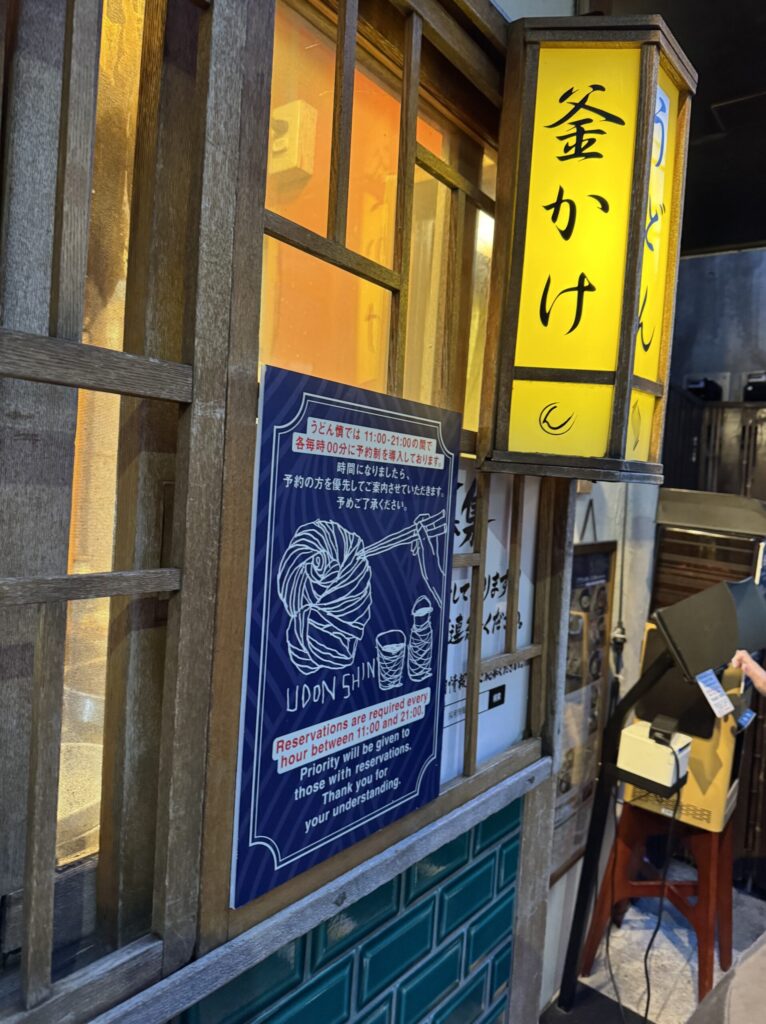
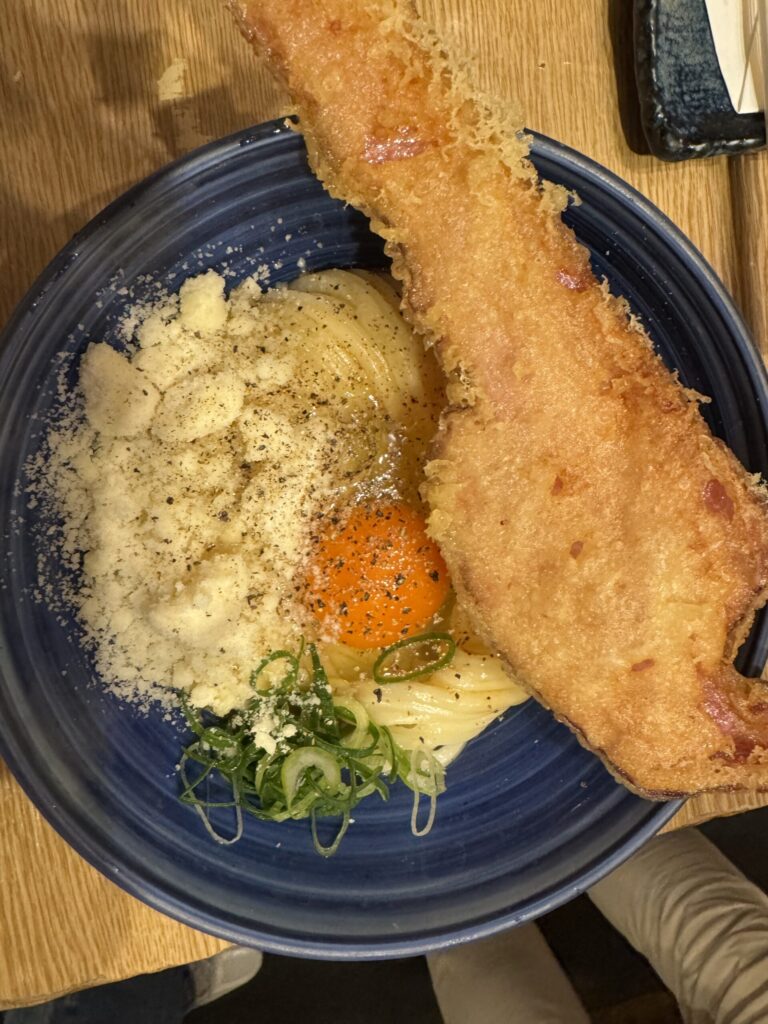
This was the only place we went more than once, and the two meals we had were so delicious and simple and satisfying. The teeny tiny shop, located on a random side street in Shinjuku, makes their noodles in house, rolling and cutting them minutes before they go into the giant pot of hot water. I know this for certain because you can see the whole process, from ball of dough to plated dish, as you wait for your turn to be seated. So you’ve got incredibly fresh, perfect noodles, and then a whole bunch of choices for what else is on your plate.
My aunt went with cold soy sauce noodles with cod roe both times, first with a soft boiled egg, then with seaweed. According to her, she preferred the cold udon because she didn’t have to chose between waiting to dig in and burning her mouth! A smart choice, and both styles were delicious. The most noteworthy thing about them to me, and the reason I consider Udon Shin to be the master of the noodle, is that the texture and flavor of the noodles themselves was not diminished by their coldness. They didn’t clump, but also didn’t taste watered down, and while that probably seems like the smallest thing… to me, it takes real genius to master the simple technical details like this.
I preferred the warm udon. My first trip I had the carbonara – raw egg, Parmesan cheese, black pepper, butter, and the best idea ever, tempura bacon. Mind blowingly good. So rich and deep, but not so much that you get flavor fatigued. I went a little more classic when we returned, forgoing the cheese and bacon for cod roe and green onions and soy sauce. But again it was a perfect combination, hitting all the flavor and texture notes to produce a freakin symphony of delight. Combined with the perfect tempura we started with, and the sparkling cider that I miss to this day, these were easily my favorite meals from our entire time in Tokyo.
Side Note: Udon Shin is open from 11am until 10pm every day. Your best bet to minimize wait time is a weekday afternoon – but even then, there was some waiting (see below for a full explanation). It is absolutely worth it, I promise.
Don’t forget to check out everything else I’ve written about Tokyo while you’re here – from my full itinerary to my favorite eats, and everything in between!
Want to Keep Wandering?
The adventure doesn’t stop here!
Dive into another of my favorite travel tales, tips, and sober chaos:
Or Crack open the chaos and explore my destinations, advice, and big ol’ feelings:
Want more weird, wonderful chaos in your inbox?
No spam. No nonsense. Just good stories and the occasional travel tip.
I will include a note here about how you actually organize yourself into a seat in the wee spot of Udon Shin – it was a little confusing the first time, so I hope this helps someone else experience the pure bliss of this noodle shop.
HOW TO UDON SHIN
First of all, you can make a reservation online, but it costs 2000 Yen per person – and this price is just a straight up fee, not applied towards your food or drink. I suppose it might be worth it if you want to come during prime time, or your time is limited, but it seemed silly for us. If you don’t go that route, then here’s what you’ll do.
- Arrive at the restaurant & get a number – you will see people lined up to the left of the door. Do not get in the line. That step comes later. Instead, walk past them to the small machine just in front / to the right of the door where you can select your language and put in the number in your party and get a ticket with a number and stuff on it.
- Scan the QR code – it will take you to a page with your approximate wait time. It’ll give you the option to enter an email and phone number so you can get a text when it’s time to come back, or you can just keep an eye on this page / refresh it every two minutes like I did. At this point, you go away – there’s a cute square at the end of the block, or a Starbucks nearby. Either way, I don’t think they want you to hang out in the mostly residential street in front of the restaurant, causing a jam up in the narrow alley.
- When the text or web page tells you it’s time, come back to the restaurant and get into the line that you bypassed the first time. You’ve still got some waiting to do, but you’re getting close!
- Someone will come give you menus – decide exactly what you’re having, including drinks and such, as they’ll be back soon to take your order (before you go in and sit down).
- When it’s your turn, they’ll seat you, and your food and drinks will arrive almost immediately. Enjoy, it’s so forking good, and I’m so jealous that you’re there!
- You can probs add more food/drink after your seated, but I’m not sure how it works as we didn’t need to add anything.
- At some point, the bill has been put in a little cup on your table. When you’re finished eating (no one will rush you, but I was always conscious of the people patiently waiting their turn outside) you will walk the three steps or so to the machine across from the first table by the door. Here you will scan said bill and enter cash (CASH ONLY) to pay. It will spit out your change and off you will go, completely sated and at peace with the world!

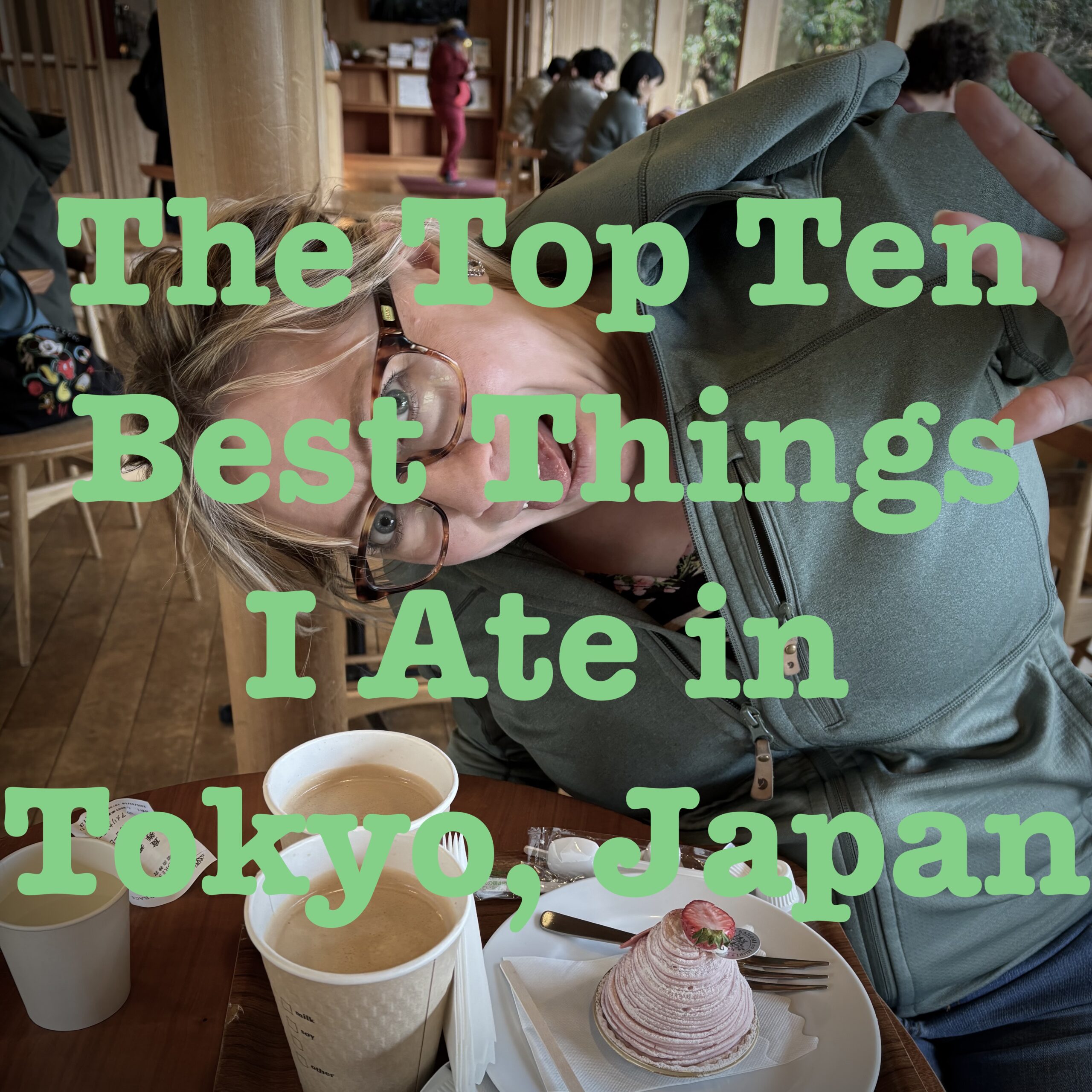
Leave a Reply